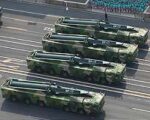In a significant step toward enhancing mobility and interoperability within the Nordic defense framework, Denmark has taken delivery of its first Patria 6×6 armored personnel carrier (APC). The vehicle is part of the multinational Common Armoured Vehicle System (CAVS) program led by Finland and marks a key modernization milestone for the Royal Danish Army.
Strategic Context: Denmark’s Force Modernization and Regional Defense Posture
The delivery of the Patria 6×6 comes amid Denmark’s broader effort to modernize its land forces in response to evolving security dynamics in Northern Europe. With increased emphasis on NATO readiness and regional defense cooperation—particularly through NORDEFCO (Nordic Defence Cooperation)—Denmark is prioritizing interoperable platforms that align with allied capabilities.
The Patria 6×6 acquisition supports this strategy by providing a modular wheeled platform compatible with those fielded by Finland, Latvia, Sweden, and Germany. Denmark formally joined the CAVS program in March 2023 after signing a technical arrangement with Finland’s Ministry of Defence.
Patria 6×6 Platform Overview
The Patria 6×6 is a modern wheeled armored vehicle designed for troop transport and multi-role missions. It offers a balance between protection, mobility, and affordability. Key specifications include:
- Configuration: 6×6 all-wheel drive
- Crew capacity: Driver + commander + up to 10 dismounts
- Weight: Approx. 24 tonnes gross vehicle weight
- Engine: Diesel engine rated at ~294 kW (400 hp)
- Protection level: STANAG Level upgradable; base protection against small arms fire and artillery splinters
- Mobility: Independent suspension system; central tire inflation; amphibious capability optional
The platform is based on lessons learned from the proven Patria AMV series but optimized for lower lifecycle costs and easier maintenance. Its modularity allows configuration as an APC, command post vehicle (CPV), ambulance, or mortar carrier.
CAVS Program: A Multinational Approach to Land Mobility
The Common Armoured Vehicle System (CAVS) initiative was launched by Finland in cooperation with Latvia in early 2020 to develop a standardized family of wheeled armored vehicles. The goal is to reduce unit costs through joint procurement while enhancing operational synergy among participating nations.
The current CAVS participants include:
- Finland: Lead nation; initial operator since mid-2021
- Latvia: Received first batch in October 2021; plans for over 200 units
- Sweden: Joined in April 2023; evaluating variants for rapid deployment forces
- Germany: Joined as observer in late-2023; potential future partner for NATO standardization efforts
- Denmark: Joined March 2023; initial deliveries now underway
The CAVS framework allows each nation to tailor subsystems—such as communications suites or weapon stations—while maintaining commonality at the chassis level. This approach simplifies logistics during joint operations and enables shared training pipelines.
Danish Requirements and Customization Pathway
The Royal Danish Army plans to use the Patria 6×6 primarily as an APC within its motorized infantry battalions. While exact order quantities have not been publicly disclosed, Danish defense officials have indicated that several dozen units are expected over multiple tranches through the late-2020s.
Danish-specific modifications under consideration include:
- C4I Integration: Linkage with national BMS systems compatible with NATO standards such as Link-16 or MIP-based architectures.
- Add-on Armor Kits: Enhanced ballistic protection packages depending on mission profile.
- Tactical Weapon Stations: Remote-controlled weapon stations (RCWS) likely equipped with .50 cal machine guns or automatic grenade launchers.
- Sustainment Package: Local MRO support via Danish industry partners under offset agreements.
A key advantage cited by Danish procurement officials is lifecycle cost efficiency compared to tracked alternatives like CV90 IFVs or legacy M113 variants still in limited service. The wheeled platform also improves strategic mobility across Denmark’s road network and facilitates faster deployment within Europe under NATO’s Very High Readiness Joint Task Force (VJTF).
NATO Interoperability Gains and Future Prospects
The induction of the Patria 6×6 aligns closely with NATO’s push for greater force interoperability among member states’ land components. By adopting a common platform alongside other Nordic countries—many of which contribute forces to NATO Enhanced Forward Presence (eFP) missions—the Royal Danish Army enhances both logistical compatibility and operational cohesion during multinational deployments.
This acquisition also positions Denmark well for future collaborative upgrades under CAVS Phase II initiatives, which may include integration of hybrid-electric drivetrains, active protection systems (APS), or autonomous driving capabilities currently being tested by Finnish industry partners such as Patria Land Systems Oy and Millog Oy.
Danish Industrial Participation and Offset Opportunities
Danish defense firms are expected to play a role in sustainment activities including depot-level maintenance, spare parts supply chain management, and potentially localized production of selected subcomponents. While no formal industrial offset package has been publicly announced yet, sources close to Forsvarsministeriets Materiel- og Indkøbsstyrelse (DALO) suggest negotiations are ongoing regarding domestic value-added commitments tied to future tranches.
This mirrors similar arrangements seen in Latvia where local firms such as Defense Partnership Latvia Ltd were contracted for assembly work under supervision from Patria engineers. Such partnerships not only reduce logistical tail risks but also build long-term sovereign support capacity within participating nations’ defense ecosystems.
A Measured Step Toward Greater Strategic Autonomy?
The adoption of the Patria 6×6 underscores Denmark’s commitment to collective security while also signaling intent to strengthen national capabilities through flexible platforms that can evolve over time. As geopolitical tensions persist across Europe’s eastern flank—and Arctic access routes grow more contested—the ability to field interoperable yet adaptable ground systems will remain critical for small-to-medium-sized militaries like Denmark’s.
If successfully integrated into frontline formations over the coming years—and supported by robust training pipelines—the Patria fleet could become a cornerstone asset enabling both national defense missions and rapid coalition deployments across Northern Europe under EU or NATO mandates alike.









